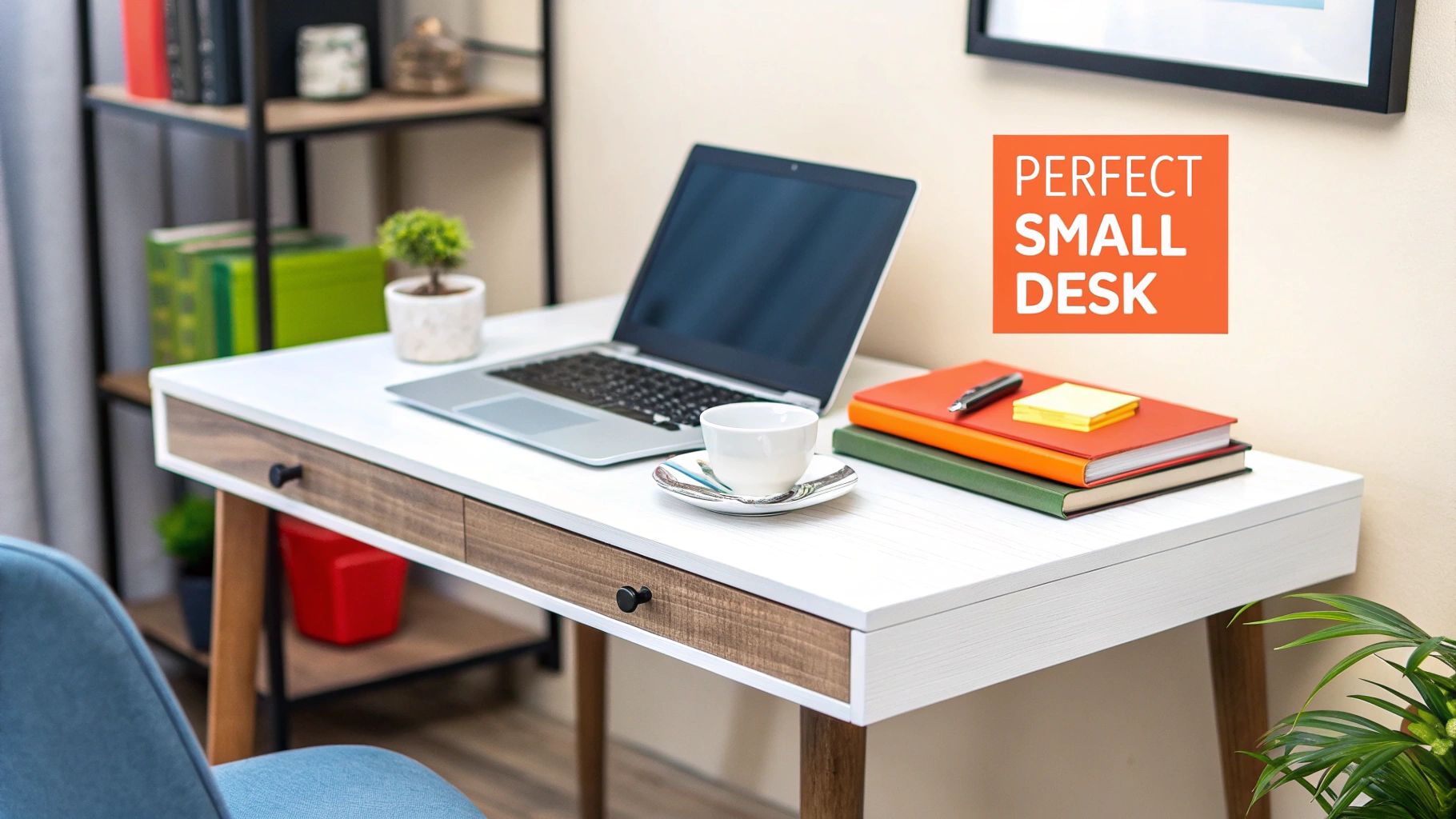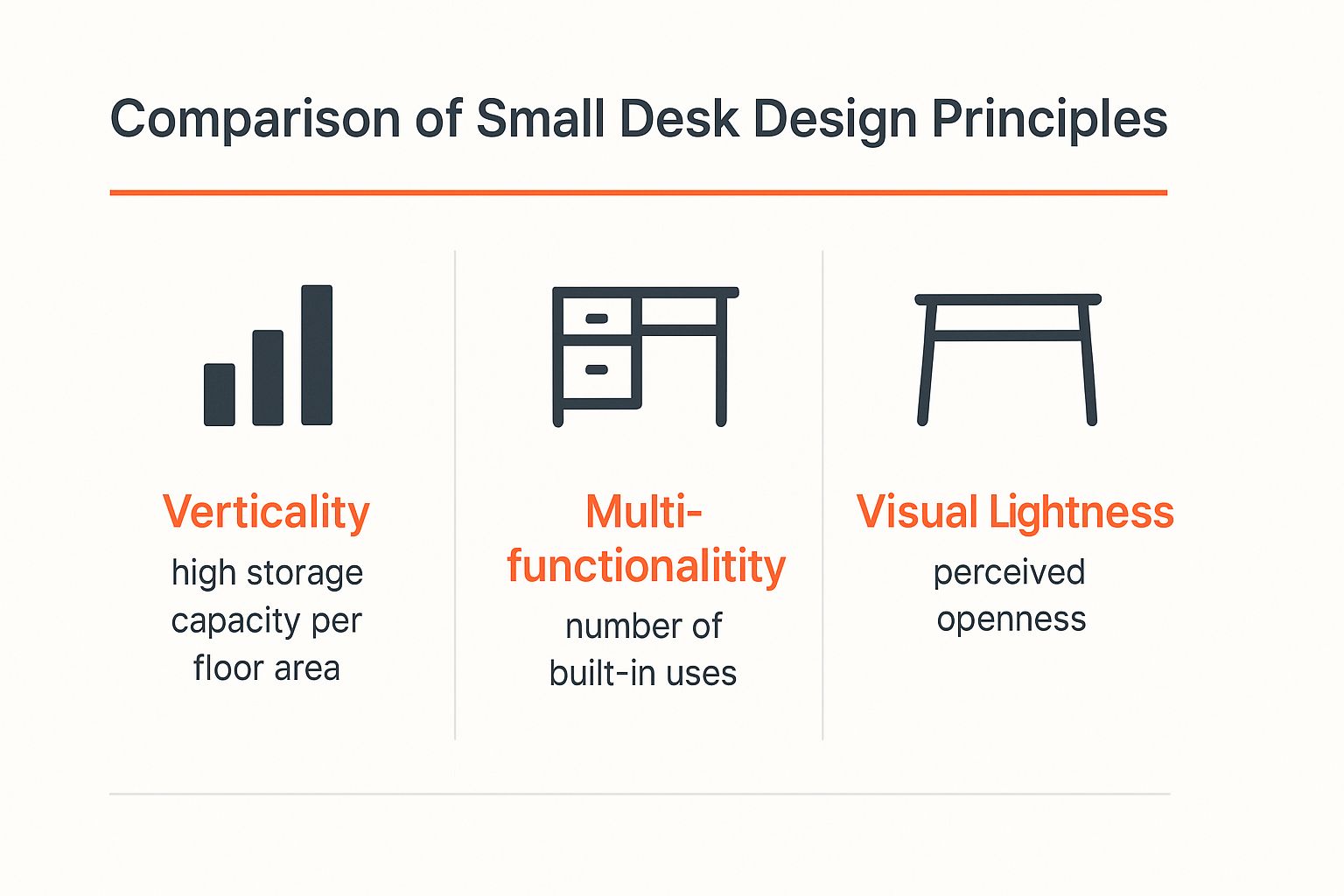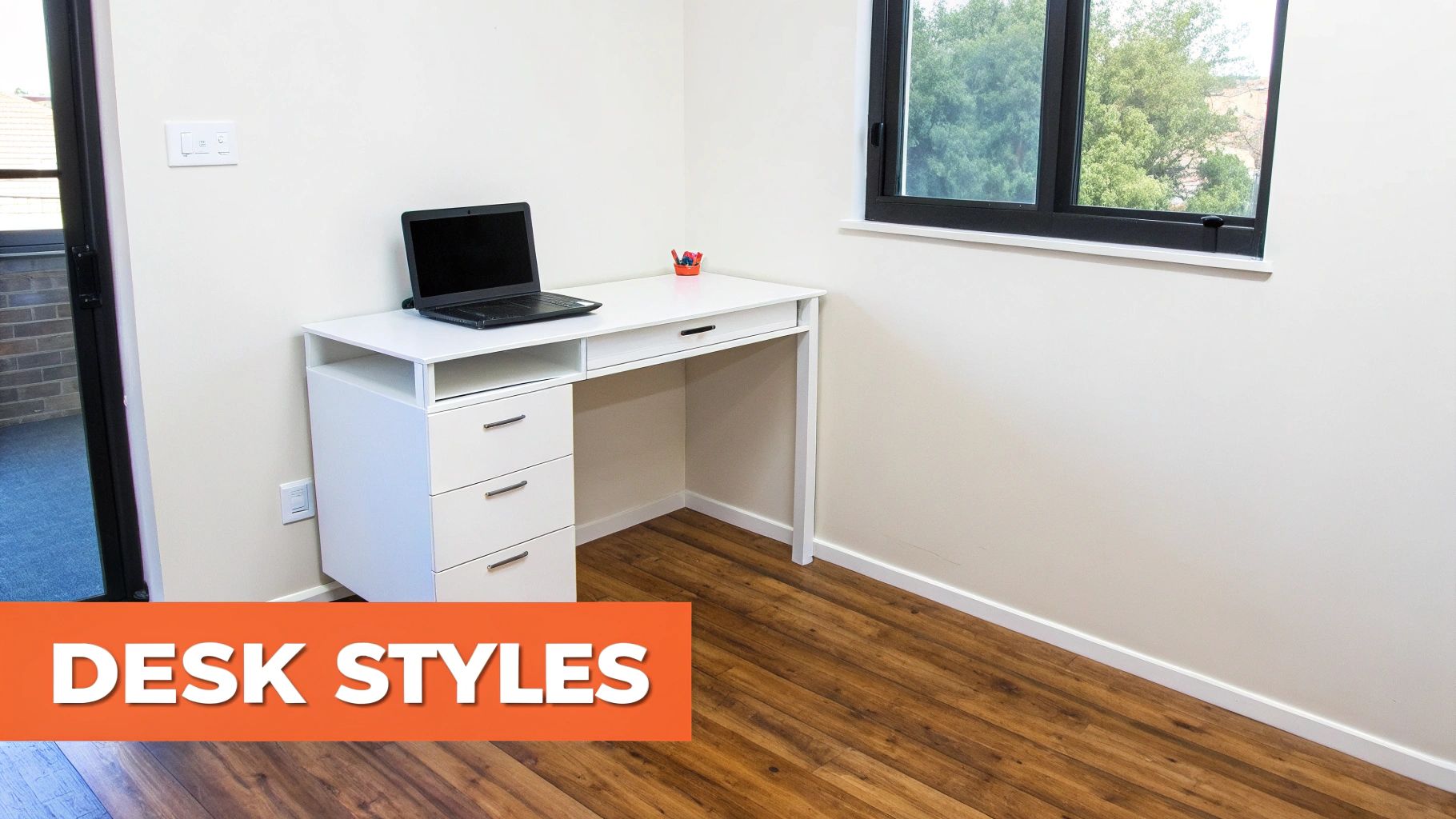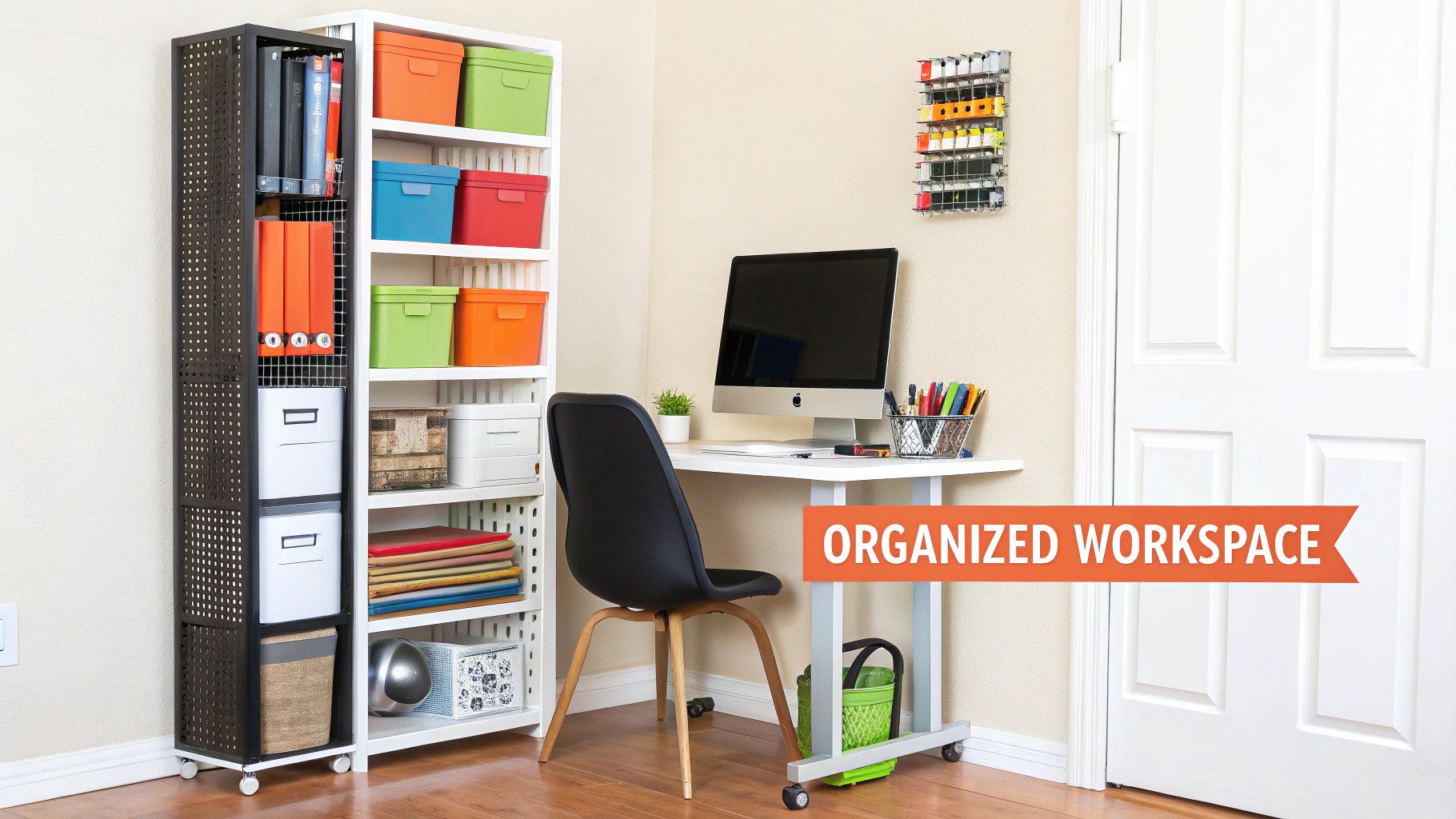-
CALL US:
- (866) 952-3456
The best desks for small spaces are often the ones you barely notice—wall-mounted, corner, or folding models that cleverly maximize your floor space without asking you to sacrifice function. When you're tight on room, you want designs that think vertically with built-in storage or pull double-duty with multi-purpose features to make every square inch count.

Trying to carve out a dedicated workspace in a small home can feel like a game of Tetris you just can't win. With so many of us working remotely and living in more compact spaces, a thoughtfully chosen desk is more critical than ever. It's not just about cramming a flat surface into a corner; it's about creating a command center that's productive, comfortable, and actually looks good.
This guide is here to tackle that challenge head-on. We're here to prove that a limited footprint doesn't mean you have to compromise on having an efficient and stylish setup. The demand for clever, space-saving solutions has absolutely exploded, and the furniture market has responded in a big way.
The global home office desk market was valued at roughly $10.5 billion in 2023 and is on track to hit $15.3 billion by 2032. This huge jump is driven by people needing desks that fit into smaller homes, with space-efficient designs now making up over 30% of sales in some areas. For a deeper dive, check out the full report from Dataintelo.
Before you even think about picking a desk, you need a solid plan. The very first step, always, is to understand the exact dimensions you're working with. Our guide on how to measure furniture is the perfect place to start. It’ll help you sidestep that all-too-common mistake of buying a piece that completely overwhelms your room.
Think of this guide as your roadmap. It will give you the confidence to find the perfect fit for any tight spot, including:
We’ll walk through all the clever desk types out there, from wall-mounted models that have a zero footprint to versatile corner desks that turn odd spaces into productive zones. By the end, you'll know exactly what to look for.
Finding the right desk for a small space isn't about just grabbing the smallest one you can find. It’s more about smart design, where every inch and every feature is designed to make your room feel bigger and work harder. Think of it less like a piece of furniture and more like a Swiss Army knife for your home office—compact, but loaded with unexpected functionality.
To get it right, you need to understand three core ideas that can turn a simple desk into a space-saving machine. Once you get these concepts down, you'll have a mental checklist to size up any desk and know for sure if it will work with your space, not against it.
The best desks for tight quarters are always built on a foundation of verticality, multi-functionality, and visual lightness. Grasping these principles is the real key to carving out a workspace that feels productive and calm, even when you're short on square footage.
The infographic below shows you exactly how these three design principles come together to create a workspace that's both efficient and easy on the eyes.

As you can see, the most effective desks often blend all three elements, giving you a solution that’s just as practical as it is stylish.
This whole shift toward smarter, more flexible furniture is a direct result of how we live and work now. Our homes are getting cozier, and remote work is the new normal, so it's no surprise that we're demanding furniture that fits this new reality.
It's a massive trend. Surveys show that in the U.S. alone, over 40% of remote workers are now based in homes smaller than 1,000 square feet. This has seriously fueled the demand for desks that don't just fit, but adapt to everything from video calls to deep-focus work. You can read more about these workplace trends in the full report from Coworking Cafe.
This need for adaptability has pushed designers to get more creative, leading to more modular and reconfigurable desks than ever before. The goal isn't just to squeeze a desk into a small room anymore; it's to find one that actually makes that space better.

Alright, now that we’ve got the core principles down, let's get into the good stuff: the actual desk styles that make it all happen. Think of choosing a desk like picking the right tool for a job. Each design is engineered to solve a specific spatial problem, whether that's freeing up precious floor space, taming an awkward corner, or creating a workspace that completely disappears when you clock out.
Breaking down the most popular options helps you match a desk’s strengths to your room’s unique layout and your own work habits. This isn't just about finding a desk that fits; it's about finding one of the best desks for small spaces that actively improves your home.
To make things even clearer, let's put the most common compact desk types side-by-side. This quick comparison will help you pinpoint which style is the best fit for your specific needs before we dive into the details of each.
| Desk Type | Best For | Key Advantage | Potential Drawback |
|---|---|---|---|
| Wall-Mounted/Floating | Ultra-tight spaces and minimalist aesthetics | Takes up zero floor space, creating an open feel | Very limited storage and surface area |
| Corner Desk | Awkward, unused corners in bedrooms or living rooms | Maximizes dead space and offers a large work surface | Limited placement options within a room |
| Ladder Desk | Rooms needing combined workspace and storage | Excellent vertical storage in a small footprint | Requires a solid wall and can be less sturdy |
| Folding/Hideaway Desk | Multi-purpose rooms (guest rooms, dining areas) | Completely disappears to reclaim the space | Smaller work surface and less robust construction |
Looking at them this way, you can already start to see which ones might be a good match. Now, let’s explore what makes each of these designs tick.
Imagine a workspace that takes up absolutely zero floor space. That's the magic of a wall-mounted or "floating" desk. These designs attach directly to your wall, creating a clean, streamlined surface that looks like it's hovering.
For anyone in a studio apartment, a narrow hallway, or any spot where every single square inch counts, these are the ultimate solution. This style is perfect for minimalists who just need a spot for a laptop and a notebook. The open floor underneath is a game-changer, making the room feel way bigger and less cluttered.
Of course, there's always a trade-off. That sleek design comes at the cost of storage. With no legs or base, you won't find any built-in drawers, so you’ll have to get creative with separate shelving if you have more than a few basics.
A floating desk embodies the principle of "visual lightness" perfectly. By keeping the floor clear, it reduces visual clutter and creates an illusion of openness, a critical benefit in compact living areas.
Let's be honest, corners are the most neglected parts of any room. They're often just awkward, empty voids. A corner desk is specifically built to turn that dead zone into a surprisingly productive nook.
By fitting snugly into a 90-degree angle, it gives you a ton of surface area without jutting out and tripping you up. This makes it a fantastic choice for a bedroom or living room where you need to carve out a work zone without messing up the room's flow. Plus, many come with handy built-in shelves or drawers. If you want more tips on taming tricky spots, check out our guide on furniture placement ideas.
The main thing to keep in mind is placement. You’re pretty much locked into the corners of your room, which might not have the best lighting or the most professional-looking background for your video calls.
Ladder desks are the undisputed masters of vertical space. They lean against a wall, combining a compact work surface with a series of shelves that climb upward, creating an all-in-one workstation and storage hub.
This design is a brilliant move for anyone who needs to keep books, binders, and decor organized without buying a separate bookshelf. They strike a great balance between function and style, giving you tons of storage while keeping things light and airy. Because they draw your eye up, they can even trick you into thinking a room with low ceilings is taller.
When it comes to multi-functional living, nothing beats a folding or hideaway desk. These incredibly clever designs can be folded down, collapsed, or tucked away into what looks like a normal cabinet once your workday is done.
This "now you see it, now you don't" feature is a lifesaver in spaces that have to wear multiple hats, like a guest room that doubles as an office or a dining area. Models range from simple fold-down wall units to more complex pieces that masquerade as a stylish console table. They give you the power to completely reclaim your space, helping you create a firm boundary between work and personal life.
Picking the right style of desk is a huge first step, but the real magic is in the details. The right features can take a simple compact desk from just "good enough" to a true command center for your home. It’s the difference between a desk that just fits into a space and one that actually makes that space work better for you.
Think of it like this: any car can get you from point A to B. But it's the features like GPS, cruise control, and heated seats that make the journey efficient and enjoyable. The same logic applies here. Let's break down the features that really make a difference.
In a small room, clutter is the enemy. A desk with integrated storage is your best weapon in that fight. The trick is to find designs that cleverly build in organization without adding bulk.
A clutter-free desk isn't just about looking neat; it’s about being able to focus. Time and again, studies show that an organized environment cuts down on mental distractions, letting you concentrate on what actually matters.
Nothing ruins the look of a compact setup faster than a tangled nest of cords. It just screams messy. Modern desks often have smart solutions to prevent this exact problem, like built-in grommets, channels, or under-desk trays that guide cables neatly out of sight.
Better yet, some of the best small desks now come with integrated power outlets or USB ports. This is a huge space-saver. It gets rid of that bulky power strip on the floor and keeps your setup clean and functional. It’s features like these that turn a simple desk into one of the key home office must-haves that actually make you more productive.
Your comfort and health matter, even if your workspace is tiny. Ergonomics should never be an afterthought. This is where you see some real innovation, especially in cities where every square foot counts. 'Transformable' furniture is common, and that focus on multi-use design has pushed ergonomics to the forefront.
It's no surprise that height-adjustable desks are so popular, with standing desks now making up over 20% of home office desk sales in some areas. For more on these trends, you can check out research from firms like Cognitive Market Research.
The materials you choose also play a big role in both how the desk works and how it feels in the room. Lighter-colored woods or glass can make a small space feel more open and airy. On the flip side, a sturdy metal frame ensures your desk can handle daily use without wobbling. When you focus on these essential features, you’re not just buying a desk—you're genuinely upgrading your home.

Picking out the perfect compact desk is a great first step, but it's really only half the battle. To create a workspace that’s actually functional and feels good to be in, you have to think about everything around the desk, too. It’s less about just placing furniture and more about creating a complete, self-contained little work zone where every piece plays its part.
When you take the time to optimize the surrounding area, you basically multiply how effective your small desk can be. Think of it like buying a powerful engine for a car—it won’t do you much good without the right tires and suspension to back it up. A few smart moves with organization, seating, and lighting can turn a tight corner into a true productivity hub.
When you're out of floor space, there's only one direction to go: up. Using your walls is hands-down the best way to keep your desk surface from becoming a cluttered mess, which in turn helps keep your mind clear.
Going vertical also draws the eye upward, which has the clever effect of making the whole room feel a bit taller and more open. If you're looking for more inspiration, our guide on storage solutions for small spaces is packed with great ideas.
Your desk isn't an island. All the accessories you pair it with can either make your space better or just add to the clutter. The trick is to choose supporting items that were also designed with a small footprint in mind.
A slim-profile chair is a must. Seriously. Look for chairs without arms or ones that are designed to tuck completely underneath the desk. This one simple thing can visually give you back a few square feet of space. You could also grab a monitor stand that has built-in drawers or a little rolling cart to slide under the desk for hidden storage.
Smart lighting is another crucial element. A single, well-placed lamp can make a small area feel more spacious and reduce eye strain. Avoid bulky floor lamps and opt for a slim desk lamp or a wall-mounted sconce to save surface area.
It's about more than just the furniture. By optimizing your home office workflow, you can boost your productivity even more. When your tools, chair, and lighting all work together in harmony, your compact workspace becomes a real powerhouse.
Picking out the right desk for a tight spot usually brings up a handful of questions. Getting straight, practical answers can be the difference between a desk you love and one that just gets in the way. Let's tackle some of the most common concerns to help you feel totally confident in your choice.
Think of this as the final gut check before you buy. You've seen the styles and features, but these are the real-world details that will make sure your new desk actually works for your life.
A desk becomes "too small" the moment it stops supporting your essential gear and starts forcing you into bad posture. You want to save space, of course, but not at the expense of basic function or your own well-being. The real goal is finding that sweet spot between a minimal footprint and enough surface area to get things done.
To keep from feeling boxed in, here are a few minimums to keep in mind:
At the end of the day, the "right" size is personal. A desk you only use for paying bills can be a lot smaller than one you need for a full eight-hour workday with a couple of monitors. Always measure your must-have gear first to figure out your true minimum.
Absolutely. It’s actually a fantastic choice. The idea that standing desks are only for sprawling corporate offices is a total myth. Many companies now design compact standing desks—some under 40 inches wide—specifically for apartments, dorms, and tight corners.
Another brilliant option is a standing desk converter. This is a gadget that just sits on top of your current desk or table, letting you lift your monitor and keyboard up to standing height. You get all the ergonomic perks without having to buy a whole new piece of furniture.
A standing desk is one of the best desks for small spaces because it gets you moving and can make your work area feel way less confining. Just be sure to measure its maximum height to make sure it won’t hit any low shelves, art, or light fixtures when you raise it all the way up.
In a small room, visual clutter feels ten times worse, and nothing makes a space look messier than a spaghetti monster of wires. Good cable management isn't just nice to have—it's essential for keeping a compact workspace feeling clean and organized. Luckily, there are a few simple tricks.
You can start by looking for a desk with built-in solutions, like grommet holes for routing cords or a little tray underneath. If the desk you love is on the minimalist side, you can easily add your own fixes:
Spending just five minutes taming your cables will make an enormous difference in how clean and professional your small workspace feels.
Don't let the thought of building that new desk add any more stress to your plate. The team at Assembly Smart specializes in fast, professional furniture assembly, making sure your new workspace is set up perfectly and is ready to go. Book your hassle-free assembly service today!